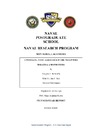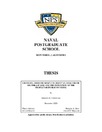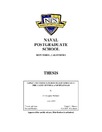Deepening U.S. Partnerships in the Indian Ocean Region
| dc.contributor.author | Malley, Michael | |
| dc.contributor.author | Kapur, Paul | |
| dc.contributor.author | Jacobs, Ryan | |
| dc.contributor.author | Gussenhoven, Michael | |
| dc.date | Period of Performance: 10/01/2015-03/31/2017 | |
| dc.date.accessioned | 2018-04-05T23:57:19Z | |
| dc.date.available | 2018-04-05T23:57:19Z | |
| dc.date.issued | 2016 | |
| dc.identifier.other | NPS-N16-N359-A | |
| dc.identifier.uri | https://hdl.handle.net/10945/57724 | |
| dc.description.abstract | Increased naval patrols, infrastructure construction, and diplomatic visits characterize China’s expanding political, economic, and military presence in the Indo-Asia-Pacific region. This expansion creates challenges and opportunities for regional states and extra-regional powers that depend on the Indian Ocean’s sea-lanes. The alignment strategies undertaken by regional states in response to Chinese moves will critically influence how the region develops over the next 15 years. This project sought to identify the alignment strategies of smaller countries in the Indian Ocean Region (IOR) in the face of increasing Chinese presence in the region as well as the emerging Sino-Indian competition (the subject of a previous study by the same PIs). The aim was to inform the development of naval strategy and policy by providing USN leaders with insights that enable them to identify the most promising opportunities for building partnerships in the IOR. Focusing mainly on Sri Lanka and Indonesia, this project gathered a wide array of qualitative data through archival research and meetings with high-level officials and experts, mainly in India, Indonesia, and Sri Lanka. In general, we found that India remains strongly inclined to balance against China and aims to strengthen its partnerships with the United States and other countries to achieve this aim. However, smaller countries in the IOR are much less inclined to balance against China. They seek to enhance their ties with the United States and China, but wish to avoid taking sides in a Sino-American contest. This calls for a high degree of sensitivity, creativity, and patience in developing maritime security partnerships in the IOR. | en_US |
| dc.description.sponsorship | Naval Research Program | en_US |
| dc.description.sponsorship | Prepared for Topic Sponsor: OPNAV N51; Research POC Name: RDML William McQuilkin | en_US |
| dc.publisher | Monterey, California. Naval Postgraduate School | en_US |
| dc.rights | This publication is a work of the U.S. Government as defined in Title 17, United States Code, Section 101. Copyright protection is not available for this work in the United States. | en_US |
| dc.title | Deepening U.S. Partnerships in the Indian Ocean Region | en_US |
| dc.type | Report | en_US |
| dc.contributor.corporate | Naval Postgraduate School | |
| dc.contributor.corporate | Naval Research Program | |
| dc.contributor.department | National Security Affairs (NSA) | |
| dc.subject.author | China | |
| dc.subject.author | India | |
| dc.subject.author | Indian Ocean | |
| dc.subject.author | Indonesia | |
| dc.subject.author | Sri Lanka | |
| dc.subject.author | strategy | |
| dc.subject.author | security cooperation | |
| dc.description.funder | NPS-N16-N359-A | en_US |
| dc.identifier.npsreport | NPS-N16-N359-A |





